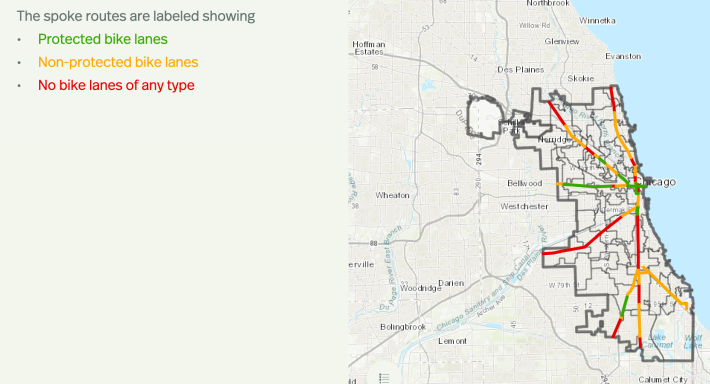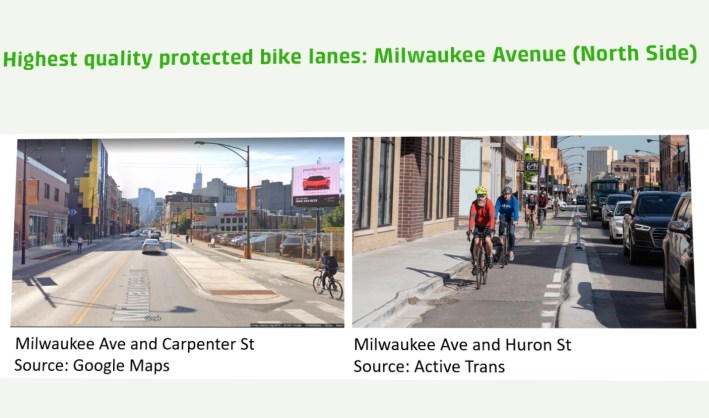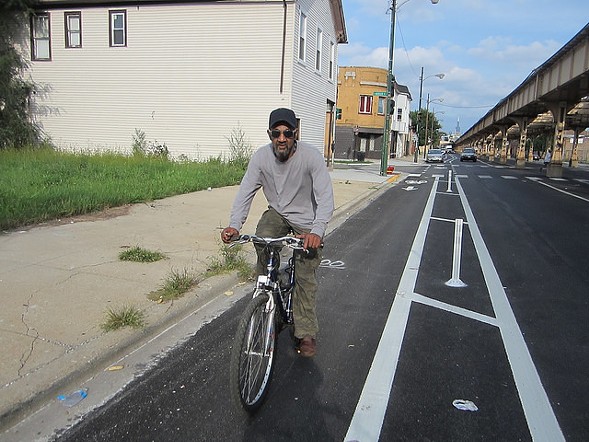Almost decade ago in July 2011, Chicago's first protected bike lane opened on a half mile of Kinzie Street downtown. the next year, the Chicago Streets for Cycling Plan 2020 was released, envisioning a 645 mile citywide bike network that would accommodate riders of all ages and abilities. Currently Chicago has a little over 350 miles of bike lanes, but only 25 of those miles are physically protected from moving traffic. If you talk to someone who bikes in Chicago, it’s likely you’ll hear them say they want more protected bike lanes. Protected bike lanes have been shown to reduce injuries and increase cycling rates according to People for Bikes research.
The Active Transportation Alliance is renewing the call for more protected bike lanes in Chicago. Less than 15 percent of the recommended bikeway mileage Streets for Cycling plan has been built over the last nine years. There has been a surge in folks cycling for recreation and transportation due to the COVID-19 pandemic, and ATA sees cycling as key to Chicago’s recovery from the crisis. The city’s recently passed capital plan with $17 million set aside for cycling improvements, plus the infusion of federal COVID relief funds, provides an opportunity to make progress on creating a citywide bike network and build on the momentum of the current bike boom. ATA asserts that by not seizing the opportunity to build more protected lanes, Chicago risks losing the health, sustainability, and equity gains made thanks to the increase in cycling.
The Streets for Cycling plan identified seven key "Spoke Routes," mostly diagonal streets that could potentially serve as bicycle superhighways connecting neighborhoods with downtown, with enough road width to potentially accommodate protected bike lanes. These are:
- Clark Street
- Milwaukee Avenue
- Lake Street/Randolph Street
- Archer Avenue
- Vincennes Avenue
- South Chicago Avenue
- State Street/Wabash Avenue
Currently much of the length of these streets lacks protected bike lanes. ATA’s analysis revealed that only 10.7 miles of the 70.7 miles on these routes feature physically protected bike lanes. The South Side Spoke Routes only contain 2.4 miles of protected bike lanes. The remaining sixty miles of Spoke Routes contain 31.2 miles of “lower quality” non-protected bikeways and 28.8 miles miles with no bikeways. The State Street and Archer Avenue Spoke Routes have no bikeways for the routes.

ATA argues that one of the barriers to protected bike lanes is the lack of coordination and cooperation between the Chicago, Cook County, and Illinois transportation departments. However, the Chicago Department of Transportation has jurisdiction over most of the Spoke Route mileage. Another major problem is aldermanic prerogative, the de-facto ability of City Council members to veto projects in their wards.
However, it seems that the biggest obstacle is the lack of political will to even design and fund protected bike lanes in the first place. If the political will was there, I am confident this would lead to agency cooperation.
ATA adds that the biking experience across Chicago is varied due to inconsistent infrastructure along spoke routes. In an ideal world, every bike trip would be a low-stress experience. ATA has analyzed spoke routes according to their comfort level. The majority of spoke route mileage is low-comfort and does not meet the needs of riders of all ages and abilities.
ATA states, “Even the few miles with protected bike lanes don't always provide a safe, comfortable ride. The designs vary, ranging from plastic bollards to concrete protection.” The group singled out the Lake Street protected bike lanes, the longest single stretch of protected bike lanes on a Spoke Route, located below the elevated Green Line tracks as an example of a protected bikeway route that fails to provide a high-comfort experience.
I agree that Lake Street is not a low-stress ride. In addition to high levels of noise from the 'L', I encountered vehicles parked in the bike lane. I would love for CDOT to create protected intersections that prevent drivers from entering the lanes. ATA rated portions of the Milwaukee Avenue spoke route that feature concrete curb protection as examples of high-quality protected bike lanes.

ATA also blames the stalled progress on building a protected bikeway network on community, and a staffing shortage at CDOT. However, the group identified lack of dedicated funding for building bikeways as the main roadblock. The $17 million for cycling improvements in Chicago’s new capital plan is a start in the right direction. More funding could be provided through President Biden’s American Jobs Plan infrastructure bill if it is passed. One way we can get the ball rolling on more building protected bike lanes is by letting Mayor Lightfoot, CDOT Commissioner Gia Biagi, and the City Council know we want more than just paint. You can voice your support through a petition at the bottom of ATA’s protected bike lanes campaign webpage.



